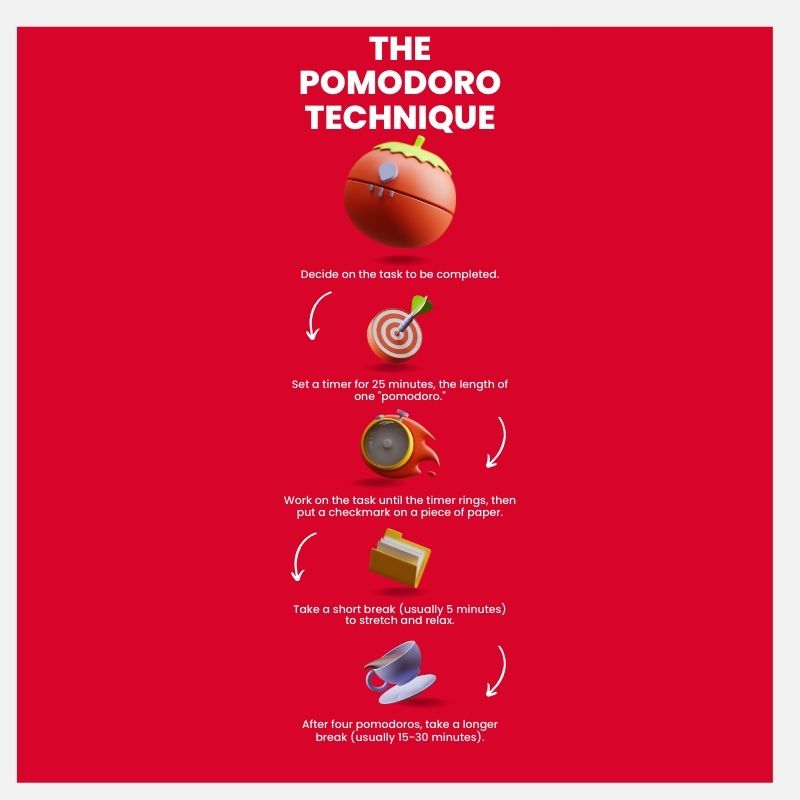
Introducing the concept of the Pomodoro Technique as a time management method designed to improve productivity and focus. Highlight its potential benefits for mental well-being and overall fulfillment.
Understanding the Pomodoro Technique
The Pomodoro Technique, developed by Francesco Cirillo in the late 1980s, is a time management method designed to enhance productivity and focus. At its core, the technique revolves around breaking work into intervals, typically 25 minutes in length, known as Pomodoros, separated by short breaks of around 5 minutes. The method derives its name from the Italian word for tomato, inspired by the tomato-shaped kitchen timer used by Cirillo during his university days.
The Pomodoro Technique is grounded in the principles of timeboxing and attention management. By working in focused bursts, individuals can capitalize on their peak levels of concentration while allowing themselves regular breaks to rest and recharge. This structured approach helps combat procrastination, minimize distractions, and promote a sense of accomplishment and momentum.
TIP: Begin your Pomodoro sessions by setting clear objectives and prioritizing tasks based on importance and urgency. Break down larger projects into smaller, manageable chunks to facilitate progress and maintain focus throughout each Pomodoro interval.
The Science Behind the Pomodoro Technique

The effectiveness of the Pomodoro Technique is supported by various psychological principles and cognitive theories. One key concept is the serial position effect, which suggests that people are more likely to remember information presented at the beginning (primacy effect) and end (recency effect) of a study session. By breaking work into focused intervals, individuals can capitalize on these memory effects to maximize retention and comprehension.
Additionally, the Pomodoro Technique aligns with research on attentional resources and cognitive fatigue. Studies have shown that sustained attention on a single task can lead to mental fatigue and a decline in performance over time. By incorporating regular breaks into the workday, the Pomodoro Technique helps replenish depleted attentional resources and sustain mental energy levels, thereby enhancing overall productivity and focus.
TIP: Experiment with different Pomodoro session lengths and break durations to find the optimal balance for your cognitive rhythms and work preferences. Pay attention to your energy levels and adjust your schedule accordingly to maintain peak performance throughout the day.
The Benefits of Time Blocking
Time blocking, a complementary technique to the Pomodoro Technique, involves scheduling specific time periods for focused work, meetings, and personal activities. By allocating dedicated blocks of time to different tasks and priorities, individuals can better manage their schedules and increase overall productivity.
One of the primary benefits of time blocking is its ability to create a sense of structure and organization in the workday. By proactively planning and scheduling tasks in advance, individuals can minimize decision fatigue and reduce the likelihood of feeling overwhelmed or stressed by competing priorities.
Furthermore, time blocking encourages individuals to be more intentional with their time and resources, fostering a greater sense of accountability and ownership over their schedules. By designating specific time slots for focused work, individuals can protect their most valuable asset—time—and ensure that they allocate sufficient attention and effort to their most important tasks and goals.
TIP: Use time blocking in conjunction with the Pomodoro Technique to optimize your productivity and focus. Begin each day by reviewing your schedule and identifying the most critical tasks and priorities. Allocate Pomodoro sessions to tackle these high-impact activities, and use breaks between sessions to review progress, adjust plans as needed, and recharge for the next interval of focused work.
Applying the Pomodoro Technique for Mental Wellness

Beyond its productivity benefits, the Pomodoro Technique can also promote mental wellness and work-life balance. In today’s fast-paced world, it’s easy to feel overwhelmed and burnt out by the demands of work and daily life. However, by incorporating regular Pomodoro sessions into your routine, you can create opportunities for rest, reflection, and self-care, leading to greater overall well-being.
One of the key ways the Pomodoro Technique supports mental wellness is by breaking work into manageable chunks, reducing the likelihood of cognitive overload and burnout. By focusing on one task at a time during Pomodoro sessions, individuals can avoid multitasking and maintain a sense of clarity and purpose in their work.
Additionally, the Pomodoro Technique encourages individuals to take regular breaks, which are essential for rest and rejuvenation. These short intervals allow individuals to step away from their work, engage in relaxation techniques, and recharge their mental batteries, leading to improved focus, creativity, and resilience over time.
TIP: Prioritize self-care and well-being by incorporating regular breaks and relaxation activities into your Pomodoro routine. Use breaks to engage in mindfulness practices, such as deep breathing, meditation, or stretching exercises, to promote relaxation and reduce stress levels. Remember that your mental and emotional health are just as important as your productivity and achievements.
Enhancing Focus and Concentration
One of the primary benefits of the Pomodoro Technique is its ability to enhance focus and concentration during work sessions. By breaking work into short, focused intervals, individuals can capitalize on their peak levels of attention and minimize distractions, leading to greater productivity and efficiency.
Research has shown that sustained attention on a single task can lead to improved performance and better outcomes. However, maintaining focus in today’s digital age, where distractions abound, can be challenging. The Pomodoro Technique provides a structured approach to managing attention and staying on task, helping individuals overcome procrastination and maintain momentum in their work.
Additionally, the Pomodoro Technique encourages individuals to cultivate mindfulness and present-moment awareness during work sessions. By immersing themselves fully in the task at hand, individuals can minimize mental chatter and external distractions, leading to deeper levels of engagement and satisfaction with their work.
TIP: Create a distraction-free work environment by eliminating potential sources of interruption, such as phone notifications, email alerts, and social media notifications. Use tools and techniques, such as the Pomodoro Timer app or browser extensions, to block distracting websites and stay focused on your work. Experiment with different strategies for enhancing concentration, such as the “Pomodoro Sprint” technique or the “Pomodoro Challenge,” to find what works best for you.
Cultivating Mindfulness and Presence
Incorporating mindfulness practices into Pomodoro sessions can deepen the benefits of the technique for mental well-being and focus. Mindfulness involves paying deliberate attention to the present moment without judgment, allowing individuals to become more aware of their thoughts, feelings, and bodily sensations.
During Pomodoro breaks, consider integrating mindfulness techniques such as deep breathing, body scanning, or mindful walking. These practices can help alleviate stress, promote relaxation, and enhance overall awareness and presence. By taking a few moments to pause and connect with the present moment, individuals can cultivate a greater sense of calm and clarity, making it easier to return to work with renewed focus and energy.
TIP: Experiment with different mindfulness practices to find what resonates best with you. Whether it’s guided meditation, a mindful breathing exercise, or a short walk in nature, prioritize activities that promote relaxation and mental clarity during Pomodoro breaks. Remember that consistency is key, so aim to incorporate mindfulness into your daily routine to reap the full benefits over time.
Overcoming Procrastination and Resistance
Procrastination is a common challenge that many individuals face, but the Pomodoro Technique can be a powerful tool for overcoming this barrier to productivity. By breaking tasks into manageable intervals and setting a timer for focused work, individuals can create a sense of urgency and momentum that helps combat procrastination.
When faced with resistance to starting a task, consider using the “Five-Minute Rule” or “Just Get Started” technique. Commit to working on the task for just five minutes, knowing that you can stop once the timer is up if you still feel resistant. More often than not, getting started is the hardest part, and once you’re in the flow of work, it becomes easier to continue.
Additionally, identify and address any underlying reasons for procrastination, such as fear of failure, perfectionism, or lack of clarity. Break tasks down into smaller, actionable steps, and focus on making progress rather than striving for perfection. By taking consistent, incremental steps toward your goals, you can build momentum and overcome procrastination more effectively.
TIP: Use the Pomodoro Technique as a tool for breaking through resistance and procrastination. Start with shorter Pomodoro sessions if necessary and gradually increase the duration as you become more comfortable with the process. Remember that consistency and persistence are key to overcoming procrastination and achieving your goals.
Setting Clear Goals and Intentions
Setting clear goals and intentions is essential for maximizing the effectiveness of the Pomodoro Technique. Before starting a Pomodoro session, take a moment to clarify what you hope to accomplish during that time. Define specific objectives and prioritize tasks based on their importance and urgency to ensure that you’re focusing on the most meaningful work.
One effective strategy for goal setting is the SMART criteria, which stands for Specific, Measurable, Achievable, Relevant, and Time-bound. By applying these principles to your goals, you can create a clear roadmap for success and ensure that your efforts are aligned with your overarching objectives.
Additionally, regularly review and adjust your goals as needed to stay aligned with your priorities and values. Celebrate progress and milestones along the way, and use setbacks as opportunities for learning and growth. By setting clear goals and intentions, you can harness the full potential of the Pomodoro Technique and achieve greater levels of productivity and fulfillment.
TIP: Use a planner or task management tool to track your goals and progress over time. Break larger goals down into smaller, actionable tasks, and allocate Pomodoro sessions to work on them systematically. Regularly review your goals and make adjustments as needed to stay focused and motivated on your journey.
Managing Energy Levels and Fatigue
Managing energy levels and fatigue is crucial for sustaining productivity and well-being throughout the day. The Pomodoro Technique offers a structured approach to managing energy by alternating focused work intervals with short breaks, allowing individuals to maintain optimal performance and prevent burnout.
Pay attention to your body’s natural energy rhythms and schedule Pomodoro sessions during times when you feel most alert and focused. Consider incorporating energizing activities into your breaks, such as stretching, taking a short walk, or enjoying a healthy snack, to replenish your mental and physical energy.
Additionally, prioritize activities that support overall well-being, such as getting regular exercise, maintaining a healthy diet, and getting enough sleep. By taking care of your physical health and honoring your body’s need for rest and recovery, you can sustain long-term productivity and vitality.
TIP: Listen to your body and honor its signals for rest and rejuvenation. If you find yourself feeling fatigued or unfocused during a Pomodoro session, take a short break to recharge before returning to work. Experiment with different activities and techniques to find what helps you replenish your energy levels most effectively.
Tracking Progress and Reflecting on Results
Tracking progress and reflecting on results are essential practices for optimizing performance and effectiveness with the Pomodoro Technique. Regularly review your Pomodoro sessions and assess your productivity and focus levels to identify patterns, trends, and areas for improvement.
Keep a Pomodoro log or journal to record your work sessions, including the tasks you worked on, the duration of each Pomodoro interval, and any insights or observations you gained during the process. Use this information to identify your peak productivity hours, your most productive tasks, and any recurring distractions or obstacles that may be hindering your progress.
Additionally, take time to reflect on your results and celebrate your accomplishments along the way. Acknowledge your successes and progress, no matter how small, and use setbacks as opportunities for learning and growth. By adopting a growth mindset and embracing the process of continuous improvement, you can maximize the benefits of the Pomodoro Technique and achieve greater levels of productivity and fulfillment.
TIP: Set aside dedicated time each week to review your Pomodoro log and reflect on your progress and results. Use this time to identify areas for improvement, set new goals, and celebrate your achievements. By regularly tracking your progress and reflecting on your results, you can stay focused, motivated, and accountable on your journey toward greater productivity and success.
Creating a Supportive Environment
Creating a supportive environment is essential for maximizing the effectiveness of the Pomodoro Technique and fostering a culture of productivity and well-being. Surround yourself with people, resources, and tools that support your goals and priorities, and minimize distractions and interruptions in your workspace.
Communicate your Pomodoro schedule and boundaries to colleagues, friends, and family members to ensure that they respect your focused work time. Set clear expectations and boundaries for meetings, email communications, and other potential distractions, and prioritize uninterrupted blocks of time for deep work and concentration.
Additionally, cultivate a workspace that promotes focus, creativity, and well-being. Designate a dedicated area for work that is free from clutter and distractions, and personalize your space with elements that inspire and motivate you. Experiment with lighting, decor, and ergonomics to create a comfortable and conducive environment for productive work.
TIP: Take proactive steps to minimize distractions and interruptions in your environment, such as turning off notifications, closing unnecessary tabs or applications, and using noise-cancelling headphones if needed. Establish clear boundaries with others and communicate your availability and preferences for focused work to ensure that you can maintain productivity and concentration during Pomodoro sessions.
Balancing Work and Rest
Balancing work and rest is essential for sustaining productivity, creativity, and well-being over the long term. The Pomodoro Technique offers a structured approach to managing this balance by alternating focused work intervals with short breaks, allowing individuals to maintain optimal performance and prevent burnout.
Recognize the importance of rest and recovery in promoting overall well-being and productivity. Schedule regular breaks throughout your workday to rest, recharge, and engage in activities that bring you joy and fulfillment. Use Pomodoro breaks as opportunities to step away from your work, take a breath, and reset your focus for the next interval of work.
Additionally, prioritize restorative activities outside of work, such as spending time with loved ones, pursuing hobbies and interests, and engaging in relaxation techniques. By cultivating a healthy balance between work and rest, you can sustain your energy, creativity, and motivation over the long term and achieve greater levels of success and fulfillment in all areas of your life.
TIP: Prioritize self-care and well-being by scheduling regular breaks and downtime throughout your day. Use Pomodoro breaks as opportunities to engage in activities that nourish your body, mind, and spirit, such as taking a short walk, practicing mindfulness, or enjoying a healthy snack. Remember that rest is an essential component of productivity and success, so honor your need for rest and recovery to maintain balance and vitality in your life.
Adapting the Pomodoro Technique for Different Tasks and Contexts
The flexibility of the Pomodoro Technique allows it to be adapted to a wide range of tasks and contexts, making it a versatile tool for enhancing productivity and focus in various settings. Experiment with different Pomodoro session lengths, break durations, and intervals based on the nature of your work, personal preferences, and energy levels.
For tasks that require deep concentration and creative thinking, consider extending Pomodoro sessions to allow for more uninterrupted work time. Alternatively, for tasks that involve repetitive or monotonous activities, shorter Pomodoro sessions may be more suitable to maintain engagement and prevent burnout.
Additionally, explore how you can integrate the Pomodoro Technique into different aspects of your life, beyond traditional work tasks. Use Pomodoro sessions to tackle household chores, pursue personal projects, or engage in hobbies and creative pursuits. By harnessing the power of the Pomodoro Technique across various domains, you can maximize your productivity and fulfillment in all areas of your life.
TIP: Customize the Pomodoro Technique to suit your unique needs and circumstances. Experiment with different approaches and adapt the technique as needed to optimize your productivity and well-being. Remember that the goal is not perfection but progress, so be flexible and open to adjusting your approach over time.
Overcoming Common Challenges and Pitfalls
While the Pomodoro Technique can be a highly effective productivity tool, it’s not without its challenges and pitfalls. Common obstacles include difficulty maintaining focus, resisting distractions, and feeling overwhelmed by the pressure to perform within strict time intervals.
To overcome these challenges, cultivate self-awareness and mindfulness during Pomodoro sessions. Notice when distractions arise and gently redirect your attention back to the task at hand. Practice self-compassion and resilience in the face of setbacks, acknowledging that occasional lapses in focus are natural and to be expected.
Additionally, be realistic about your expectations and avoid overcommitting yourself to unrealistic goals or timeframes. Break tasks down into smaller, manageable chunks, and prioritize self-care and well-being to prevent burnout. Remember that productivity is not about working harder but working smarter, so focus on quality over quantity and prioritize tasks that align with your values and priorities.
TIP: Develop strategies for managing common challenges and pitfalls encountered during Pomodoro sessions. Experiment with techniques such as the “Two-Minute Rule” for overcoming procrastination, the “Five-Second Rule” for overcoming hesitation, and the “Pomodoro Sprint” technique for boosting focus and motivation during challenging tasks. Remember that resilience and adaptability are key to navigating obstacles and achieving your goals with the Pomodoro Technique.
Cultivating a Growth Mindset
Finally, cultivating a growth mindset is essential for maximizing the benefits of the Pomodoro Technique and achieving long-term success and fulfillment. Embrace challenges as opportunities for learning and growth, and view setbacks as temporary setbacks on the path to mastery and excellence.
Approach each Pomodoro session with a sense of curiosity and openness, knowing that each interval of focused work brings you one step closer to your goals. Celebrate your progress and achievements along the way, and use setbacks as opportunities for reflection and course correction.
Additionally, seek feedback and support from others to help you stay accountable and motivated on your journey. Surround yourself with positive influences and role models who inspire and encourage you to reach your full potential. By fostering a growth mindset and surrounding yourself with a supportive community, you can unlock new levels of creativity, resilience, and fulfillment with the Pomodoro Technique.
TIP: Cultivate a growth mindset by reframing challenges as opportunities for growth and learning. Embrace the process of mastery and improvement, and focus on progress rather than perfection. Use affirmations and visualization techniques to reinforce positive beliefs about your abilities and potential. Remember that with dedication, perseverance, and a growth mindset, anything is possible.
The Pomodoro Technique is a powerful tool for enhancing productivity, focus, and well-being in all aspects of life. By breaking work into focused intervals and incorporating regular breaks, individuals can maximize their efficiency, creativity, and satisfaction with their work.
As you embark on your journey with the Pomodoro Technique, remember to approach each session with intention, mindfulness, and a growth mindset. Experiment with different strategies and techniques, and be open to adapting your approach based on your unique needs and circumstances.
By prioritizing self-care, managing energy levels, and maintaining a healthy balance between work and rest, you can harness the full potential of the Pomodoro Technique and achieve greater levels of productivity and fulfillment in all areas of your life.
TIP: Remember that the Pomodoro Technique is a tool to support your overall well-being and success, not an end in itself. Use it mindfully and intentionally, and prioritize what truly matters to you. By cultivating a holistic approach to productivity and well-being, you can create a life of purpose, meaning, and fulfillment.
Books:
- “The Pomodoro Technique: The Acclaimed Time-Management System That Has Transformed How We Work” – Francesco Cirillo- https://amzn.to/3ZpbG4G
- Cirillo presents an in-depth explanation of the Pomodoro Technique, showing how dividing time into focused intervals can increase productivity and promote fulfillment by eliminating distractions.
- “Deep Work: Rules for Focused Success in a Distracted World” – Cal Newport- https://amzn.to/3BaTL7D
- Newport explores strategies for getting quality work done in a world full of distractions, highlighting how the Pomodoro Technique can be a powerful tool for promoting fulfillment and personal fulfillment.
- “Make Time: How to Focus on What Matters Every Day” – Jake Knapp and John Zeratsky- https://amzn.to/3Xig2YK
- Knapp and Zeratsky offer a practical approach to prioritizing what’s important in daily life, including using the Pomodoro Technique to promote the completion and achievement of meaningful goals.
- “Flow: The Psychology of Optimal Experience” – Mihaly Csikszentmihalyi- https://amzn.to/47riL6E
- Csikszentmihalyi explores the concept of flow – the state of total absorption and focus on an activity – and how the Pomodoro Technique can help achieve this state of flow, thereby promoting fulfillment and satisfaction.
- “The Now Habit: A Strategic Program for Overcoming Procrastination and Enjoying Guilt-Free Play” – Neil Fiore- https://amzn.to/4d2g9h2
- Fiore offers strategies for overcoming procrastination and cultivating a productivity mindset, including using the Pomodoro Technique to increase focus and promote fulfillment in daily life.
Scientific articles:
- “The Effects of the Pomodoro Technique on Time Management, Concentration, and Satisfaction in a Group of University Students” – Torkan et al. (2016)
- This study examines the effects of the Pomodoro Technique on time management, concentration, and satisfaction in college students, highlighting how this approach can promote fulfillment and personal effectiveness.
- “Using the Pomodoro Technique to Enhance Productivity in Writing Psychological Reports: An Empirical Study” – Russo et al. (2014)
- This research investigates the use of the Pomodoro technique to improve productivity in writing psychological reports, highlighting how this approach can promote completion and quality of work.
- “Effects of the Pomodoro Technique on Work Efficiency” – Kim and Lee (2018)
- This study examines the effects of the Pomodoro Technique on work efficiency, highlighting how dividing time into focused intervals can increase productivity and promote fulfillment at work.
- “The Pomodoro Technique: A Neuroscientifically Based Approach to Productivity and Creativity” – Liebrenz et al. (2019)
- This research explores the neuroscientific foundations behind the Pomodoro Technique, showing how its structure can promote productivity, creativity, and fulfillment at work and in daily life.
- “The Pomodoro Technique as a Time Management Tool for Employee Well-being and Job Satisfaction” – Aritzeta et al. (2017)
- This study investigates the effects of the Pomodoro technique on employee well-being and job satisfaction, highlighting how this approach can promote fulfillment and engagement in the workplace.
Book Chapters:
- “Improving Time Management and Organizational Skills Using the Pomodoro Technique” – Capítulo sobre a técnica Pomodoro por Chou and Wang (2020)- https://amzn.to/4ei8trS
- Offers practical guidance on how to implement the Pomodoro Technique to improve time management and promote fulfillment and personal effectiveness.
- “The Wiley Handbook of Psychology, Technology, and Society” – Chapter on productivity and well-being using the Pomodoro technique by Hartmann et al. (2015)
- Explores the effects of the Pomodoro Technique on productivity and well-being, highlighting how this approach can promote fulfillment and quality of life.

POMODORO TIMER

